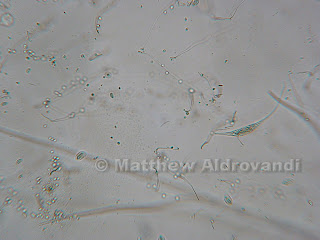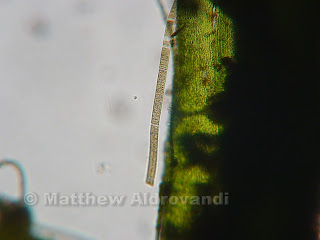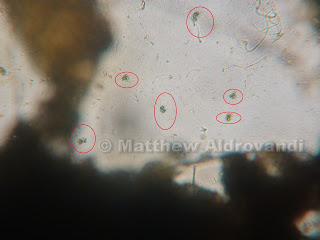Very sad Euglena video
Well, it's curtains for the ole MicroAquarium. There is an end to everything, and this week was it. I made my final observation from 3:30-4:30PM on November 12th, 2012, and then unceremoniously dumped my MicroAquarium into the trash.
This week I was able to see the cleanup crew of the microscopic world hard at work, and everything else I saw was just struggling to live. Those that can scavenge, such as the nematode below, are faring far better than those that can't.
Nematode eating plant fibers
I saw many, many beautiful diatoms in the MicroAquarium. They were like cactus spines of varying colors. How striking.
Series of photos of diatoms
They have begun to grow profusely, and I believe it is because of the change in water composition. Everything is dying; the water must be a veritable stew of nutrients.
More diatoms
Again, there is a definite feel of desperation here. The MicroAquarium has become tense and crowded, and the organisms that are still alive seem to be on their last legs, metaphorically speaking. It has literally become the land of glass houses in there.
Lyngbya Diguetii (Forest, 1954)
Close up of Lyngbya Diguetii
The two above shots show a good example of a nutrient lover. This variety of cyanobacteria has a a distinctive blue green color (Forest, 1954) and is characterized by a clear "sheath" that extends beyond the end of its cells.
Bacteria growing on a piece of detritus
In the shot above, you can clearly see a little thin object on the left that looks just like a Cuban cigar. This guy is a Nitzschia sp., a type of brown algae classified as freshwater pollution algae (US EPA, 1978). I saw a lot of these in my last viewing, and I suppose they are a sort of harbinger of doom.
Hungry Litonotus
I shot a picture of this Litonotus sp. because it is stretched out long and thin and moving very slowly, which Dr. McFarland told me is a good indication that it is starving. Kind of sad, but this thing normally goes around eating other organisms alive, so maybe it's not all that sad.
Cyclidium sp.
Finally, I found this little guy whilst traipsing around Deathtown, which Dr. McFarland identified as a Cyclidium sp. These suspension feeders are characterized by a a veil, which is an undulating membrane that comes out to capture food (Patterson, 1998). This veil has cilia lining it, which work like baleen on a whale to capture particles that are floating around in the water. The food is then packaged into food vacuoles within the cell. The contractile vacuole normally found on the outer edges of a cell of other organisms is found in the center of this organism.
Well, I guess that's it. I had a lot of fun with this MicroAquarium project, but all good things must come to an end, and this is definitely the end of this little ecosystem. Entropy is taking over and if the little tank wasn't tossed, it would just become a dried up crusty piece of glass. And hey, who knows, maybe the residents of MicroAquariumville will be content with their new lives in the gray water pipes of the Hesler Building.
A special thanks to Dr. Ken McFarland for all his help.
I would firmly believe that my MicroAquarium was full
of Seamonkeys and miniature Cuban cigars
without his excellent identification skills.
- The Aldro
Bibliography:
1. McFarland, Ken. [Internet] Botany 111 Fall 2012; 2012. [cited November 2012]. Available from: http://botany1112012.blogspot.com/
2. Patterson, DJ. Hedley, S. 1998. Freeliving Freshwater Protozoa: A Colour Guide. John Wiley and Sons, Inc.
3. Forest, HS. 1954. Handbook of Algae with Special Reference to Tennessee and the Southeastern United States. University of Tennessee Press.
4. US EPA. 1978. Fresh Water Pollution Algae. US EPA Environmental Research Center, Cincinnati, OH










.JPG)
.JPG)





























